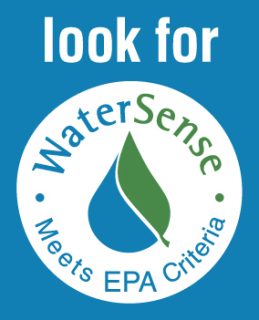
Look for the WaterSense label.
Another way to achieve water savings for you and the environment is to look for the WaterSense label when replacing fixtures or appliances. WaterSense makes it easy for you to select products that use less water, yet perform as well or better than conventional models. In fact, fixtures like bathroom faucets and toilets with the WaterSense label are designed to be 20 percent more efficient than their counterparts.
Test your toilet for leaks.
Leaky toilets can waste hundreds of gallons per week. Fixing those leaks is usually as simple as replacing the toilet flapper. Here’s how to test your toilet for a leak:
- Remove the tank lid. Drop a dye tablet or add 10 drops of food coloring to the tank.
- Put the lid back on. Don’t flush yet.
- Wait at least 10–15 minutes. If colored water appears in the bowl, you have a leak.
- Be sure to flush once the verdict is known, to avoid staining the inside of the tank.
Use your water meter to find out if you’re losing water to leaks.
The Environmental Protection Agency (EPA) estimates that the average household’s leaks can account for more than 10,000 gallons of water wasted each year. Here’s who to use your water meter to see if you have a leak:
- To determine if you have a leak, allow for 30–60 minutes during which time no water should be used on the property.
- Find your water meter, usually located in the front of the house near the street.
- Remove the lid and write down the numbers indicated on the meter at the start of the test.
- Return to check the meter reading after 30–60 minutes have passed.
- If the numbers haven’t changed, you do not have a leak. You’re done.
- If the numbers have changed, close the shutoff valves under all toilets in the house, and repeat steps 1–4.
- If the numbers have not changed after shutting off the toilet valves, you may have a running toilet that should be serviced. If the numbers have changed, you may have a leak somewhere else in the system. Consider calling in a leak detection professional.
Additional ways to save water:
- Wash only full loads of clothes and dishes – this saves water and energy.
- When washing dishes by hand, don’t leave the water running while you wash. Fill the second side of the sink with rinse water instead. Besides, you’re fighting a losing battle when you compare washing those dinner dishes by hand (16–25 gallons) with today’s energy-efficient dishwashers (4–7 gallons).
- Turn the water off when brushing your teeth or shaving. You knew this one was coming, didn’t you?
